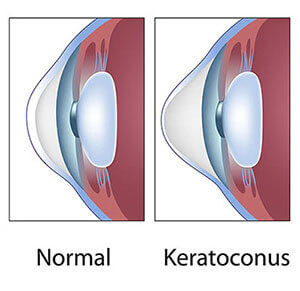In patients with keratoconus (pronounced ker-uh-toh-koh-nuhs) the cornea is cone shaped. The surface of the cornea is also irregular for those with keratoconus resulting in a distorted image being projected onto the brain. Because the cornea is irregular and cone shaped, glasses do not adequately correct the vision in patients with keratoconus since glasses cannot conform to the shape of the eye. Patients with keratoconus see best with rigid contact lenses since these lenses provide a clear surface in front of the cornea allowing the light rays to be projected clearly to the retina. This is how most cases of keratoconus are treated. However, there are some excellent new surgical options for patients with keratoconus who cannot tolerate these lenses.

Many patients are initially unaware they have keratoconus and see their eye doctor because of increasing blur or progressive changes in their prescription. Keratoconus may occur in one eye only initially but most commonly affects both eyes with one eye being more severely affected than the other. Both males and females and all ethnicities are equally affected.
The treatment approach to keratoconus generally follows an orderly progression from glasses to contact lenses to corneal transplantation. Glasses are an effective means of correction mild keratoconus. As the cornea steepens and becomes more irregular, glasses are no longer capable of providing adequate visual improvement.
Corneal transplant surgery is indicated when a patient cannot wear contact lenses for an acceptable period of time or when the vision, even with contacts, is unsatisfactory. A gas permeable contact lens is the most highly effective way to manage keratoconus and 90% of all cases can be managed this way indefinitely. The use of gas permeable contact lenses has been the mainstay of the optical management of keratoconus. These lenses, manufactured in a large variety of unique designs, provide a regular surface over the cornea to neutralize the distortion brought on by the irregular cornea. No one design is best for every type of keratoconus. Since each lens design has its own unique characteristics, the practitioner needs to carefully evaluate the needs of the individual and find the lens that offers the best combination of visual acuity, comfort and corneal health. Fitting contact lenses for keratoconic eyes is by no means simple. Numerous lenses are often fit, and it can take a great deal of time. If the cornea becomes too scarred or painful, a corneal transplant may be necessary.





